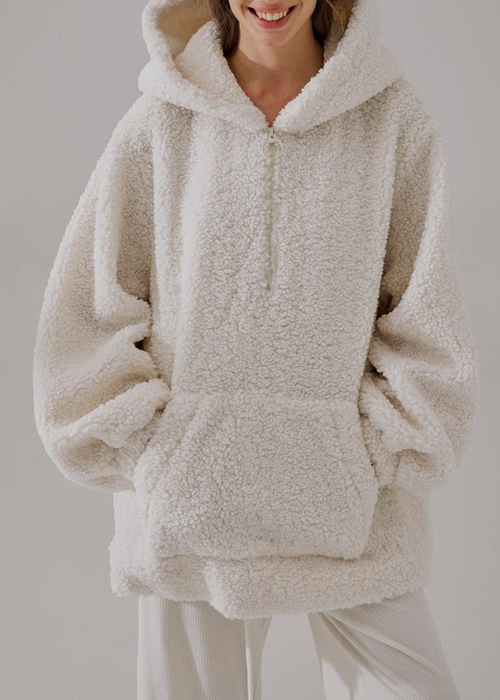Just trying to stay warm. Wearing a hoodie is one of the best ways to feel comfortable and at peace. These insignificant scraps of clothes provide you the ability to keep the cold out and protect the back of your neck, something a hat cannot do.
What kind of material is a hoodie made of? Denim or cotton can be used to make hoodies, with cotton being the more popular material. It is simple to clean, warms you up, and facilitates breathing. Get a high-quality fleece fabric instead if you want to stay warm. Compared to cotton, it is substantially better.
1. What Materials Are Used For Hoodies?
French terry or sweatshirt fleece are the common fabrics used to make hoodies, but you can also go for scuba, a double jersey like Ponte Roma, or other fabrics. Two-way knits perform better than four-way stretch knits.
The ideal materials for hoodies and sweatshirts are those that are cozy, soft, and long-lasting. For instance, fleece and cotton jerseys are wonderful because they are thick enough to produce a pliable form and are velvety and pleasant.
2. What Kind of Material Makes a Hoodie the Best?
One of these notions is the hoodie; while the forms are simple to comprehend, picking the appropriate hoodie fabric type might be difficult. A hoodie or sweatshirt can be made from a variety of fabrics. Everything will be based on your feeling of comfort and unique taste.
The climate where you live and any outdoor activities you engage in, like hiking or mountain climbing, should also be considered.
You should use clothing made of nylon or fleece for these outdoor activities, how to identify a clothing maker. The moisture will be allowed to escape as rapidly as possible while you keep toasty. Cotton and cotton-poly blends are the ideal materials for casual outdoor activities. Wool or fleece textiles work well in chilly climates.
2.1 Cotton

Cotton is the material that is most frequently used for all forms of garments. Natural cotton fiber, which is particularly absorbent, is used to make hoodies.
It’s mostly used for informal and sports settings. This chemical keeps the body dry even during strenuous activities. Cotton is the best, most breathable material for hoodies. The body gains good flexibility from it. To make diverse fabric blends like polyester, cotton fibers are mixed with a variety of other fibers.
2.2 Fleece

Due to its loose knit, fleece is a wonderful fabric for garments. There should be very little air spaces in order for your body heat to be retained and for you to remain warm and comfortable.
The fabric is also smooth, touchably soft, and incredibly absorbent. It can handle a small amount of water, so you won’t need to change straight away if you get wet. Eco-friendly materials are used to make some fleece fabrics.
It is made from plastic that has undergone a polyester transformation. So you’re taking action to preserve the environment! Feather-like natural fiber textiles are an alternative option. They are also enduring and cozy. Depending on the fabric’s quality and weave, fleece can be worn at any time and on any day.
The hoodies will be perfect for campers and hikers that climb icy mountains covered in snow.
Due to its resistance to stains, fleece is easy to clean. Additionally, the longevity of the hoodie can be increased by combining fleece with other types of cloth.
2.3 Nylon

The hoodies will be perfect for campers and hikers that climb icy mountains covered in snow.
Due to its resistance to stains, fleece is easy to clean. Additionally, the longevity of the hoodie can be increased by combining fleece with other types of cloth.
3. What Is The Warmest Material For A Hoodie?
The best hoodie fabric is found in sweatshirts and hoodies, which are constructed of cozy, supple textiles. For instance, fleece and cotton jerseys are wonderful because they are thick enough to produce a pliable form and are velvety and pleasant.
French Terry, cotton, fleece, wool, and fleece are a few of the most widely used materials. They are ideal for manufacturing garments for chilly locations and feel silky to the touch. If you live in a colder climate, a wool sweatshirt or one made of a wool and fleece mix will be hefty and thick, suitable for winter.
3.1 Sweatshirt knit

As its name implies, sweatshirt knit cloth is used to make sweatshirts. Given that many hoodies are sweatshirts with hoods, this material is a fantastic choice.
A sweatshirt’s back features a brushed texture and a knitted appearance. In addition to being easy to produce and maintain, this fabric is warm and breathable. Although there are other variations with a synthetic blend, cotton is the most common material.
Fabrics for sweatshirts can stretch from hardly perceptible to somewhat. Its knit fabric construction will allow for some stretch. However, because sweatshirt knit isn’t a form-fitting fabric, any hoodie made from it will be roomier and looser-fitting.
3.2 Jersey

Compared to jersey knit, sweatshirt knit fabric is less elastic. Because of the additional stretch, it’s a fantastic substitute for hoodies that need a little extra give. It won’t feel constrained while you walk for hours or run through the park in this material because it will move with you.
Cotton fibers or a cotton and spandex blend with added stretch can be used to make it. Cotton jerseys run the risk of shrinking and stretching out of shape. For a more stable option, think about utilizing a jersey fabric with some polyester components.
Jersey does poorly at holding structure due to its propensity to stretch. A hoodie made of this material will fit more snugly and look more comfortable and easygoing.
3.3 Wool
Compared to jersey knit, sweatshirt knit fabric is less elastic. Because of the additional stretch, it’s a fantastic substitute for hoodies that need a little extra give. It won’t feel constrained while you walk for hours or run through the park in this material because it will move with you.
Cotton fibers or a cotton and spandex blend with added stretch can be used to make it. Cotton jerseys run the risk of shrinking and stretching out of shape. For a more stable option, think about utilizing a jersey fabric with some polyester components.
Jersey does poorly at holding structure due to its propensity to stretch. A hoodie made of this material will fit more snugly and look more comfortable and easygoing.
Most wools used for hoodies are blended with another fiber to counterbalance the less than ideal characteristics of the fabric. like shrinking or losing shape after washing. To create a lightweight hoodie with strength and drape, wool and rayon work nicely together.
4. How To Choose A Hoodie Fabric: What to Look for
Are you looking for a lightweight hoodie for the warmer weather? Or do you want your hoodie to keep you warm in the winter? Both solutions require different types of cloth. Let’s examine a few characteristics that various hoodie fabric types ought to have.
4.1 Breathability
How crucial breathability is will depend on the purpose of your sweatshirt. If you intend to wear it after indulging in physically demanding activity, like running or a trip to the gym, you will need something to absorb perspiration. For you to stay cool, the hoodie needs to be air permeable.
Similarly, hoodies designed to keep you warm in the winter must be breathable so you can regulate your body temperature. Being hot and having sweat on your body can be fatal in frigid environments. To help you stay dry and comfy, make sure your hoodie is composed of a natural fiber like cotton.
4.2 Durability

People regularly wear hoodies. simply because it is so cozy to wear them. It looks like you’re wearing a big embrace. You must make sure the fabric is sturdy enough to survive wear as a result.
Any good hoodie fabric must be able to withstand several washings, a quick spin in the dryer, and bumping up against other garments in a closet.
4.3 Comfort Levels
Whatever goal you decide to pursue as a maker of custom hoodies, there is a demand. You must choose a comfortable fabric. Additionally, it need to provide unlimited movement.
Hoodies aren’t meant to be tight-fitting or restrictive. Attending a board meeting should not be done in a hoodie. They are instead cozy, casual attire designed to keep you warm when you’re unwinding.
Cotton, polyester, or a blend of the two are the best materials for hoodies. Cotton is soft and breathable, while polyester is durable and moisture-wicking. It is strong and resistant to damage, water, fire, and wear.



Leave a comment